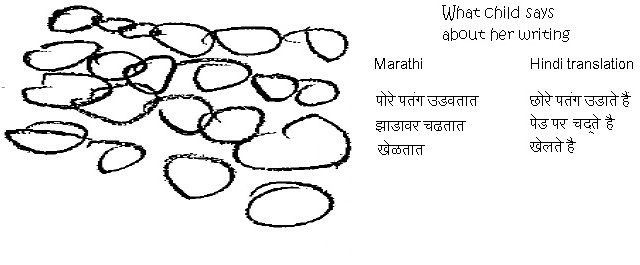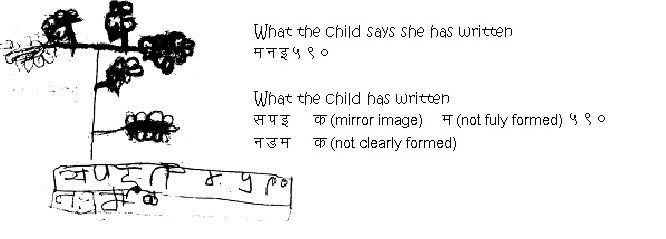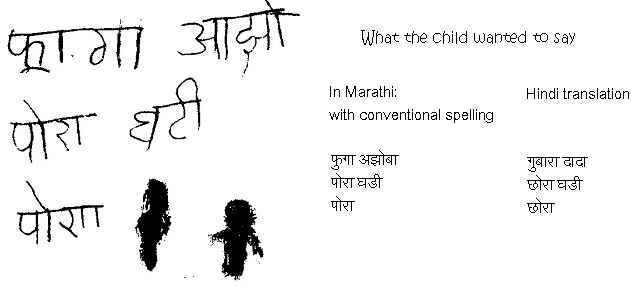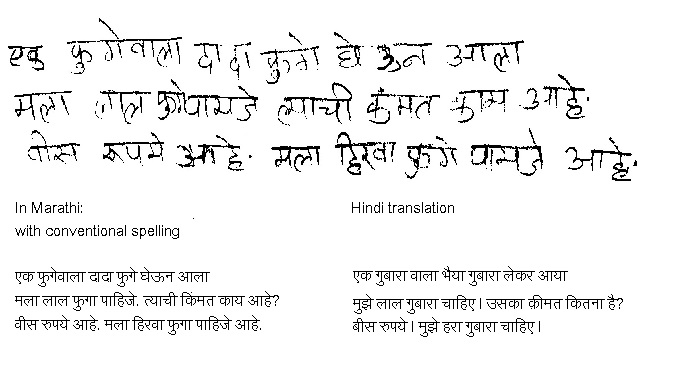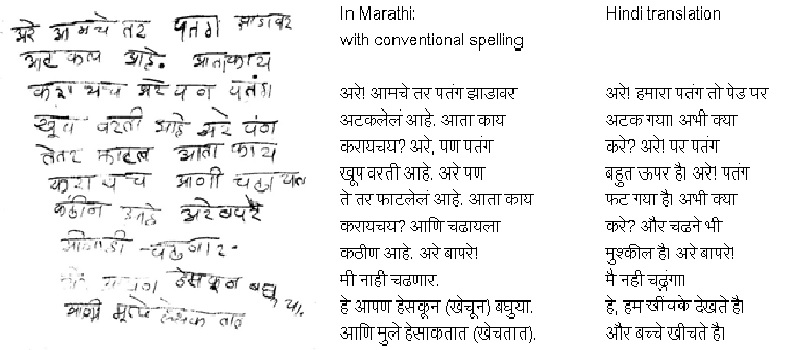Children’s Writing: How does it Emerge and Why is this Significant?
In this blog piece we share the journey of children’s writing as it emerges. We look at how children’s writing moves from squiggles, to shapes, to akshara-like figures, to invented spelling and then finally to conventional writing. It is very important for the elementary language teacher to be aware of these different phases of children’s writing. It helps us to understand not only how children learn to grasp a pencil and make meaningful shapes but also tells us about how children grapple with linking spoken language and sounds with written, conventional spelling.
The Writing Task
As part of the LiRIL assessments, we gave children one of the two pictures shown here (see Figure 1) and asked them to write a story about what they saw. We administered this assessment twice per year, over three years, when the children in our sample were in Grades 1, 2 and 3. [Please see http://azimpremjiuniversity.edu.in/SitePages/pdf/Liril_Final.pdf for a detailed view of the LiRIL study and its findings]. Each year, they saw Picture 1 once; and Picture 2 once. We encouraged children to draw if they were reluctant to write. When we couldn’t read what a child had written/drawn, we asked the child to tell us what they had written, and we wrote down whatever they said. Of course, all this happened in Marathi. In the blog, we will show you the children’s original writing in Marathi and a translation of what they wrote in Hindi. Each writing sample is followed by an explanation.
Figure 1. The pictures given to children for the LiRIL prompted writing task. Please see
So, let us look at children’s responses.
(These samples are drawn from the writing of several different children, hence, doesn’t show one child’s writing over time.)
Figure 2. Scribbling: Random shapes.
Drawn during the beginning of Grade 1.
At the earliest phase of writing (see Figure 2) the child draws or makes random scribbles. In this case, she has drawn separate shapes that are connected and organised line by line, similar to the way in which we write. The scribbles don’t look like letters. The child describes what she has written in minimal phrases, and these link to the picture of the boys flying the kite.
Figure 3. Drawing and scribbling: letter-like forms
Drawn during the beginning of Grade 1.
In Figure 3 we see that the child has started making letter like shapes. In this picture
is like the akshara ल. The child makes an initial attempt at drawing the tree in the picture she was given. You can see that proportions are not yet like the image being drawn. Orally, the child can describe the picture in brief sentences and phrases. These sentences and phrases accurately describe the picture, but there is not much flow or imagination to the way in which the thoughts are expressed.
Figure 4. Drawing and writing of letters and letter-like forms
Written during the beginning of Grade 1.
In Figure 4 we see that the child starts writing some conventional aksharas and numbers. Some of the aksharas are accurate, some are mirror images and some not yet fully formed. The child’s picture now shows some proportion and details. When asked about what she has written the child “reads out” the aksharas and numbers she has written on the page; but some of them are incorrectly recognized.
Figure 5. Invented spellings
Written at the end of Grade 1.
By now, the child has started writing conventional words. She uses invented spelling when she writes (adding extra matraas or leaving out some aksharas). She now uses regular spacing between words.
Figure 6. Conventionally spelled words appear-Sample 1
Written at the beginning of Grade 2.
By this phase, the child’s spelling is mostly correct with simple words. She does not yet separate all the words, some are clubbed together. There is no punctuation, so sentences run into each other. The writing is more like informal, quick speech than formal writing. Her picture now has proportion, details and a three dimensional look. Descriptions are brief, but accurate.
Figure 7. Conventional spelling appears
Written at the end of Grade 2.
The child’s spelling continues to be mostly correct with simple words. Matraas are still somewhat difficult for the child. She sometimes uses the wrong matraa or adds or omits an akshara. But, overall, her spelling is more accurate. She uses multiple sentences that start in different ways. Interestingly, she starts experimenting with dialogue in her story. She also plays with sentence structure, putting in questions (although she does not yet use punctuation).
Figure 8. Conventionally spelled writing
Written at the beginning of Grade 3.
The child’s spelling is almost entirely conventional, except for words that are spelt a little differently than they sound in informal language (she has confused पाहिजे with पायजे). Her sentences vary in length and structure. The child now moves from description to dialogue in her story. She explains what has happened (and builds some context for the reader) and then gives details of the interaction between herself and the balloon seller through dialogue. There is a sense of sequence in the story. With the word मुझे there is a sense of what the writer wants. This gives the story some feeling and voice.
Figure 9. Development of feeling and voice
Written at the end of Grade 3.
We can see with this piece of writing that the child’s voice comes across strongly. The writing is peppered with exclamations of अरे that really give you a feel of the children’s reaction to what has happened. There is a sense of live action as the children observe what has happened (हमारा पतंग तो पेड़ पर अटक गया) and think aloud about what to do (अभी क्या करें ), assess the situation (पर पतंग बहुत ऊपर है ) and decide the course of action (हम खींचके देखते है ). From dialogue and the thinking that forms most of this writing, suddenly, the last sentence moves into a description. We move from hearing a story, to being told a story. This shift shows a maturity in writing. It shows that the writer has a sense that a story is both about what is happening (and getting the reader involved in that through characters’ conversation) and how things are described. This writer is now showing an understanding of how stories are written.
It is interesting to look at children’s early writing attempts and see the phases they go through, isn’t it? At first, the writing looks a lot like scribbling, then the child makes connected shapes and then akshara-like shapes, before he/she starts writing recognizable aksharas. Invented spellings are also quite interesting to look at, because they represent children’s initial attempts to match sounds and aksharas. Sometimes they get it right, sometimes wrong, sometimes partially right or partially wrong. Simpler words appear first, then more complicated words and punctuation marks. What is clear is that throughout this time, from the very first sample, we can see the child’s ideas developing. From phrases, to simple descriptions, to fuller descriptions and dialogue, the child’s writing becomes richer and richer. Knowing this, it becomes necessary for teachers to talk to children about their writing and hear their stories even when they are very young. Writing down children’s stories can help encourage early writers by showing them that their own words and ideas can be put down on paper. By writing their orally dictated stories next to their drawings and invented spellings, we also show children that what they say matters to us. Finally, this becomes an opportunity for us to model “correct” spelling and punctuation for children without discouraging them from continuing to use invented spellings in their own writing.
This blog piece is based on research conducted by Menon, S. et al. (2017). Literacy research in Indian Languages: Research report of a study of literacy acquisition in Kannada and Marathi (2013-2016). New Delhi: Tata Trusts. Specifically, it has been adapted/ excerpted from The LiRIL Teacher Guidebook on Children’s Writing. Please see http://eli.tiss.edu/wp-content/uploads/2017/12/LiRIL-Guide-Part-III_Childrens-Writing.pdf for more detailed descriptions of children’s writing and classroom recommendation for teachers.
Authors: Sajitha S. Kutty and Sneha Subramaniam


